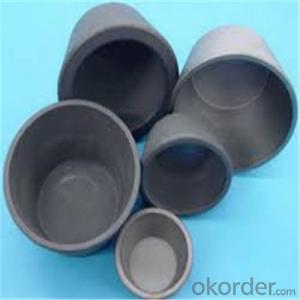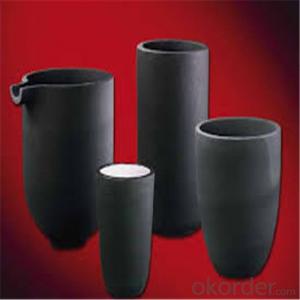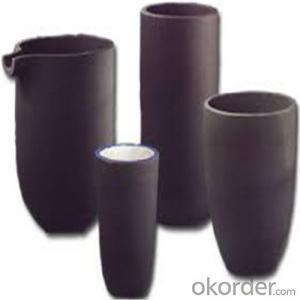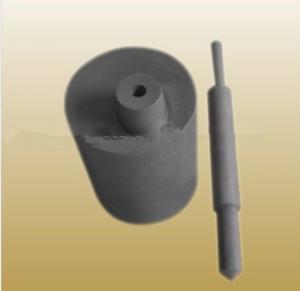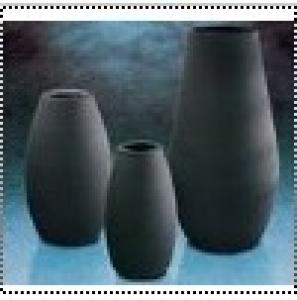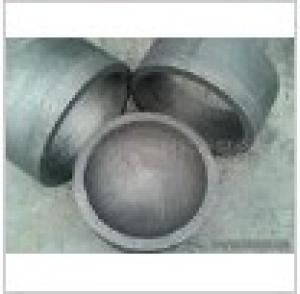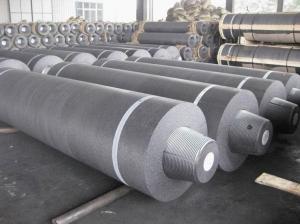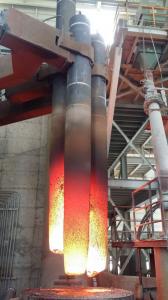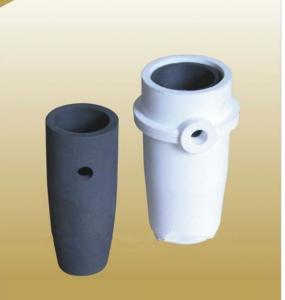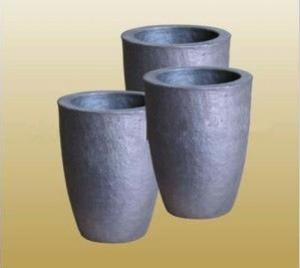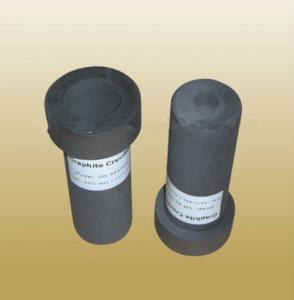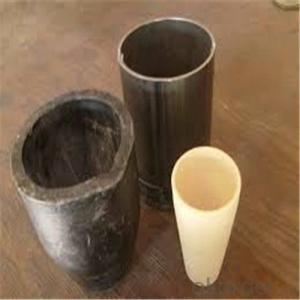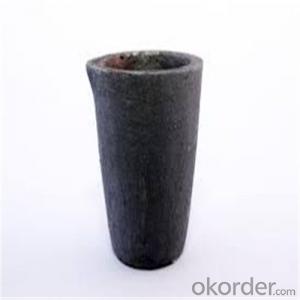SiC Crucibles For Melting Copper with High Heat Resistance
- Loading Port:
- Shanghai
- Payment Terms:
- TT OR LC
- Min Order Qty:
- 1 pc
- Supply Capability:
- 1000 pc/month
OKorder Service Pledge
OKorder Financial Service
You Might Also Like
Quick Details for SiC Crucibles For Melting Aluminium,Copper, Brass with High Heat Resistance
| Type: | High Strength, graphite crucible crucible | Application: | melting metal | Height: | as your requirements |
| Composition: | High Pure | Top Diameter: | 10-600mm | Bottom Diameter: | 10-1000mm |
| Place of Origin: | China (Mainland) | Brand Name: | Model Number: | ||
| Color: | Black grey | Si3N4%: | 5min | Fe2O3%: | 0.7max |
| C%: | 30-45 | Apparent porosity: | 30max | Refractoriness: | 1680 |
| Bulk Density: | 1.71min | Using life: | >5000 hours | MAX temperature: | 1600c |
Packaging & Delivery
| Packaging Details: | Seaworty packing or as per customer's detail requirement of graphite crucible. |
| Delivery Detail: | within 20-30 days after confirm order of graphite cru |
SiC Crucibles For Melting Aluminium,Copper, Brass with High Heat Resistance
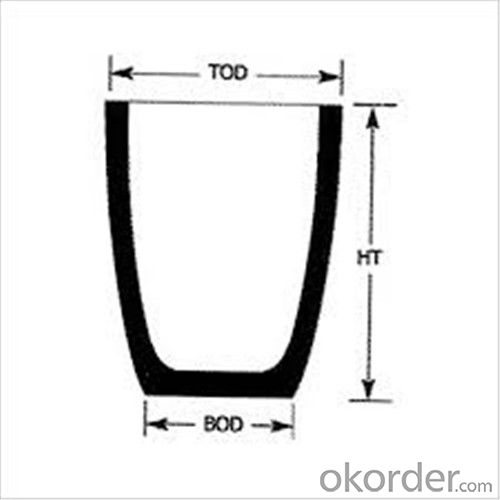

Features of SiC 95% silicon carbide sic crucible
1. resistance to deformation at high temperature,
2. thermal shock resistance, wear resistance, corrosion resistance.
3. anti-oxidation, anti- erosion.
Usage of SiC 95% silicon carbide sic crucible
electricity and steel slag trench,
coal chemical and mining transport pipeline.
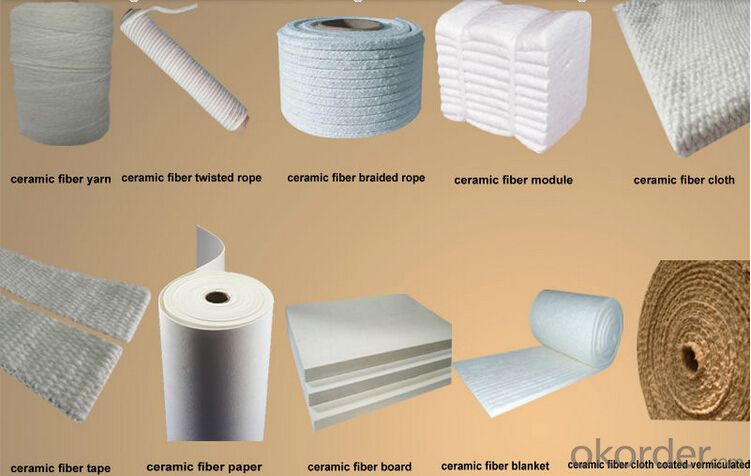
FAQ
1.What's your MOQ?
We will indicate the MOQ for each item in the quotation list. We accept the sample and trail order.
2.Can I negotiate the Prices?
Sure, we may consider discounts for bulk order of products.
3.How long will it take to complete my order?
For the stock items, we can arrange the shippment within 2~3days after received your payment. For the customized items, we will indicate the delivery time in the quotation list.
4.Can you give warranty of your products?
Yes, we extend a 100% satifisfaction guarantee on all items. Please feel free to provide timely feedback if you're not satisfied with N&D's Quality and Service. For the overseas orders, if there is a quality problem, please kindly to provide the picturers to show the problem by e-mail. We will provide the replacements to you at our cost according to actual conditions.
5.Can I visit you?
Sure. If you're a volume buyer and would like to visit our in-house products and production line, please contact us to make an appointment.
- Q:Intermediate frequency induction furnace melting copper with what dry pot?
- Graphite crucible, because copper is non-magnetic metal, so the circuit needs to be heated by the crucible, and then the heat of the crucible will melt the copper metal
- Q:Can industrial induction furnaces heat graphite?
- The material can only be guided by magnetism. The magnetic flux can not produce eddy current, so there is no way to generate heat by eddy current.
- Q:Can magnesia crucible be melted into stainless steel?
- Then the influence of phase transformation temperature and mechanical properties of the alloy. So in smelting, the crucible material, melting atmosphere and environment should be carefully considered, and strict control, to suppress all kinds of debris produced. I can't decide which one is good, just want to say a few kinds of melting non-ferrous alloy experiences the (in) in 0 according to ZL Aluminum Alloy casting, cast iron crucible;
- Q:Can a graphite crucible be used with gas burners or torches?
- Yes, a graphite crucible can be used with gas burners or torches. Graphite has a high melting point and is resistant to heat, making it suitable for use with these heat sources. Additionally, graphite is chemically inert and does not react with most substances, making it a reliable choice for various applications in laboratory or industrial settings.
- Q:Can a graphite crucible be used for ceramic molding?
- No, a graphite crucible is not suitable for ceramic molding as it is primarily used for melting and casting metals due to its high melting point and heat resistance. Ceramic molding requires materials that can withstand high temperatures and provide proper insulation, such as refractory crucibles made from materials like alumina or silica.
- Q:How do you prevent contamination from the graphite crucible during melting?
- To prevent contamination from the graphite crucible during melting, several measures can be taken: 1. Cleaning: Before each use, it is essential to thoroughly clean the graphite crucible. This can be done by removing any residual materials from previous melts, such as slag or impurities, using a suitable cleaning agent or solvent. It is important to ensure that the crucible is completely dry before proceeding with the next step. 2. Coating: Applying a protective coating to the graphite crucible can help prevent contamination. Boron nitride or other suitable coatings can be used to create a barrier between the molten material and the crucible. This coating not only prevents the crucible from reacting with the melt but also helps in easy removal of the solidified material. 3. Preheating: Before adding the material to be melted, it is advisable to preheat the graphite crucible. This step helps drive off any residual moisture or contaminants that may be present in the crucible, reducing the chances of contamination during the melting process. 4. Proper handling: During melting, it is important to handle the graphite crucible with care to avoid introducing contaminants. Using suitable tools like tongs or gloves can prevent direct contact with the crucible, preventing contamination from oils, greases, or other substances present on the hands. 5. Controlled atmosphere: In some cases, melting can be done in a controlled atmosphere to avoid contamination. An inert gas, such as argon or nitrogen, can be used to create a protective atmosphere around the crucible, preventing oxidation or reaction with the crucible material. By following these preventive measures, contamination from the graphite crucible during melting can be minimized, ensuring the purity and integrity of the melt.
- Q:How do you determine the appropriate crucible stirring mechanism for a specific application?
- Determining the appropriate crucible stirring mechanism for a specific application involves considering several factors. Firstly, you need to understand the requirements of the application, such as the type of material being stirred, the desired mixing intensity, and any specific parameters that need to be maintained during the stirring process. Next, you should evaluate the available stirring mechanisms and their capabilities. There are various options, including magnetic stirrers, mechanical stirrers, and gas bubbling stirrers. Each mechanism has its own advantages and limitations, so it's important to assess how well they align with your application requirements. Consider the properties of the material being stirred. Some materials may be sensitive to mechanical stress or temperature changes, making them better suited for gentle magnetic stirring. Others may require more vigorous mixing, which can be achieved with mechanical or gas bubbling stirrers. Additionally, assess the compatibility of the stirring mechanism with the crucible material. Certain materials may react with specific stirring mechanisms, leading to contamination or degradation. Ensure that the chosen stirring mechanism is compatible with the crucible material to avoid any adverse effects. Moreover, consider the scalability and ease of use of the stirring mechanism. If the application requires a large-scale production or frequent stirring, choosing a mechanism that is easily scalable and user-friendly can be beneficial. Lastly, consult experts or conduct experiments to validate the suitability of the chosen stirring mechanism. This can involve performing small-scale trials or seeking advice from professionals familiar with the specific application or material being stirred. Overall, determining the appropriate crucible stirring mechanism requires careful consideration of the application requirements, material properties, compatibility, scalability, and expert advice.
- Q:How do you prevent carbon contamination in a graphite crucible?
- There are several steps one can take to prevent carbon contamination in a graphite crucible: 1. Thorough cleaning is essential. Before using the crucible, it should be cleaned meticulously to eliminate any residual carbon or impurities. This can be achieved by scrubbing the crucible with a mild detergent and rinsing it with distilled water. It is crucial to avoid using abrasive cleaners or brushes that could potentially damage the crucible. 2. Preheating the graphite crucible can be beneficial in removing any remaining impurities. This can be accomplished by placing the crucible in a furnace or kiln and gradually increasing the temperature to approximately 1000°C (1832°F). It is important to perform this process slowly to prevent thermal shock and cracking of the crucible. 3. Proper handling is crucial. When handling the graphite crucible, it is important to refrain from touching the interior surface with bare hands, as this could transfer oils and contaminants. It is advisable to wear gloves or use clean, lint-free tools when working with the crucible. 4. Maintaining a controlled atmosphere is another preventive measure. Exposure to air or other reactive gases can lead to carbon contamination. To prevent this, it is recommended to use the crucible in a controlled atmosphere, such as a vacuum or inert gas environment. This can effectively reduce the likelihood of carbon contamination. 5. Overheating should be avoided. Excessive heat can cause the graphite crucible to react with the processed materials, resulting in carbon contamination. It is essential to carefully monitor and control the temperature during heating or melting processes to prevent overheating of the crucible. By adhering to these preventive measures, carbon contamination in a graphite crucible can be significantly minimized, ensuring the purity and integrity of the processed materials.
- Q:Can graphite crucibles be used for semiconductor doping?
- No, graphite crucibles cannot be used for semiconductor doping because graphite can contaminate the semiconductor material, affecting its electronic properties.
- Q:Will a graphite crucible conduct electricity?Soluble aluminum material with electric iron stove appearance
- Thermal conductivity, conductive graphite is one hundred times higher than the general non metallic minerals. Its thermal conductivity is better than steel, iron and lead metal materials. The thermal conductivity decreases with the increase of temperature, even in high temperature, graphite as adiabatic. Because graphite conductive graphite to each carbon atom and other carbon only 3 atoms formed covalent bond, each carbon atom retains 1 free electrons to transfer charge.
1. Manufacturer Overview |
|
|---|---|
| Location | |
| Year Established | |
| Annual Output Value | |
| Main Markets | |
| Company Certifications | |
2. Manufacturer Certificates |
|
|---|---|
| a) Certification Name | |
| Range | |
| Reference | |
| Validity Period | |
3. Manufacturer Capability |
|
|---|---|
| a)Trade Capacity | |
| Nearest Port | |
| Export Percentage | |
| No.of Employees in Trade Department | |
| Language Spoken: | |
| b)Factory Information | |
| Factory Size: | |
| No. of Production Lines | |
| Contract Manufacturing | |
| Product Price Range | |
Send your message to us
SiC Crucibles For Melting Copper with High Heat Resistance
- Loading Port:
- Shanghai
- Payment Terms:
- TT OR LC
- Min Order Qty:
- 1 pc
- Supply Capability:
- 1000 pc/month
OKorder Service Pledge
OKorder Financial Service
Similar products
New products
Hot products
Hot Searches
Related keywords
